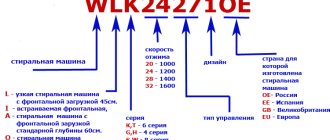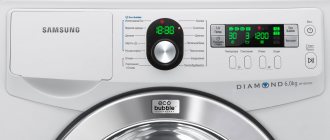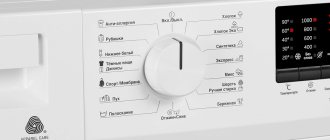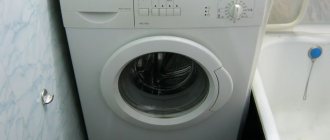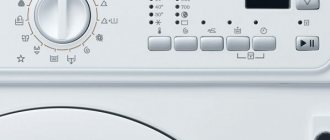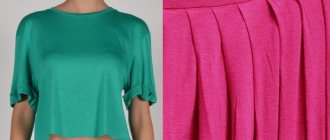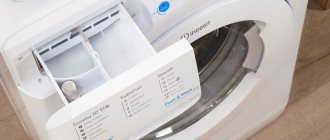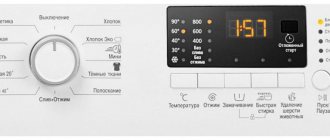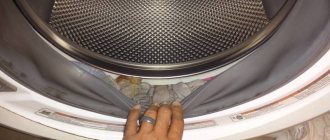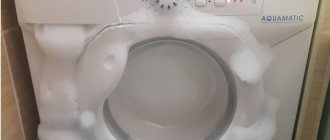So, in front of you is a wonderful modern washing machine, you are happy about it, and, of course, you are too. But when you start using it, you are surprised that out of 12 washing modes you actually use only 5: everyday, mixed, delicate, wool and quick. All other options are left out. This is partly understandable, because we don’t wash, for example, outerwear or duvets every day, and partly due to the fact that the names of the modes are completely incomprehensible. Let's try to figure out what's what and why.
Of course, different manufacturers call their modes differently, but all types of washing can be divided
into three groups :
- programs whose characteristics vary depending on the type of laundry ;
- programs aimed at saving (water or electricity - it doesn’t matter);
- programs that care about health (for example, washing for allergy sufferers, for children, washing with hot water, etc.).
Standard
Manufacturers of units offer a fairly large number of standard washing modes.
Synthetics (mixed fabrics)
The “synthetics” program is designed for fabrics such as lavsan, viscose, polyester and other synthetic materials. Cycle duration is up to 1 hour 50 minutes. Spin speed up to 800 per minute. Maximum heating temperature – +60.
The program is also suitable for items made from mixed fabrics, i.e. containing a certain percentage of threads of natural origin.
Delicate (manual)
“Delicate wash” is set if you need to tidy up fabrics such as silk, voile, cambric and others. During this cycle, the water is heated only to +40. There is no rotation of the drum: it simply sways from side to side. Spin occurs at minimum speed or is absent altogether.
Cotton
“Cotton” is a program that can be found in the SMA of any manufacturer. Traditionally used for bedding sets. Since the fabric is characterized by increased strength, the water can warm up in the range of +40…+95°C. The latter allows you to boil things.
Drum revolutions during spinning are over 1 thousand. The cycle duration is up to two hours.
Washing time in the “Cotton” mode at +40 degrees takes much less time. This cycle is intended for colored fabrics. Otherwise they may shed.
Fast
Used in all models. The “quick wash” function is suitable for lightly soiled items. Duration – 15...60 minutes. Depends on the manufacturer of the unit.
Preliminary
“Preliminary” washing takes place in two stages and is intended for heavily soiled items. In this case, the detergent is placed in both compartments of the cuvette. The first part of the cycle takes place at a lower temperature than the second. Designed for primary tissue cleansing, and the second one is the main one. During this process, the water warms up more strongly, which allows you to remove remaining contaminants.
Fact! The pre-wash mode consumes a lot of water and electricity.
Intensive
An "intensive" wash takes two to four hours and is designed for very durable fabrics. Includes mandatory soaking or pre-washing. Uses all unit resources.
Stages of washing clothes in a washing machine
Modern automatic machines carry out the entire laundry cleaning cycle independently. There are several standard stages.
After the owner has loaded things into the drum, poured powder into the cuvette and pressed the “Start” button, the machine begins drawing water. When enough liquid has been collected, the heating element begins heating the water to the set temperature.
After heating, the liquid enters the cuvette and carries powder particles with it into the drum. Some modern models provide the possibility of pre-mixing the powder with water, i.e. it enters the drum already dissolved. In this case, the fabric is less damaged, since there is no contact with solid particles of the detergent. The quality of washing is also improved.
After the detergent arrives, either washing or soaking begins (if provided for by the regime). When washing, items are spun in a drum in a soapy solution and cleaned of dirt.
Solid elements can damage the machine drum, so you should carefully check the pockets when loading laundry. Clothes with metal elements are washed by hand or in special bags.
Next comes rinsing, i.e. removing detergent residues. To do this, the washing machine pump completely pumps out the used soap solution. Then clean water enters the drum and it begins to rotate again. After the end of the stage, the water leaves through the drain hole. Some models have the option of an additional rinse. If you are allergic to the powder, then it is advisable to use this regimen.
Once the rinse is complete, it is time to spin.
The drum here rotates at maximum speed. The laundry is spread along the walls due to centrifugal force. Water goes into the tank through holes in the walls and is then pumped out from there by a pump. Cotton fabrics are pressed at maximum speed. Some delicate items should not be wrung out at all, as the material may be damaged. Spin classes:
| Class | Number of revolutions per minute | Humidity after spinning (in%) |
| G | 400 or less | 91 or more |
| F | 400-600 | 81-90 |
| E | 600-800 | 72-80 |
| D | 800-1000 | 63-71 |
| C | 1000-1200 | 54-62 |
| B | 1200-1500 | 45-53 |
| A | More than 1500 | 44 or less |
After the spin cycle, the wash cycle ends. An additional step in washing machines is drying. The presence of this function increases the cost of the machine, so choose it if there is nowhere to hang the washed items to dry. Ironing clothes after drying is difficult, as they sometimes dry out.
Economical
SMA manufacturers also offer economy cycles. They are so called because they help reduce the use of either or a resource.
Author:
Anastasia Kukushkina
I hope you enjoy the article I have prepared for you! If you find errors in it, write to me about it! I will answer any questions you have, ask them!
